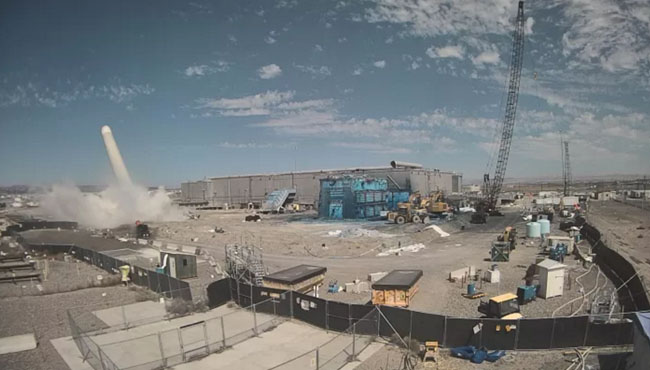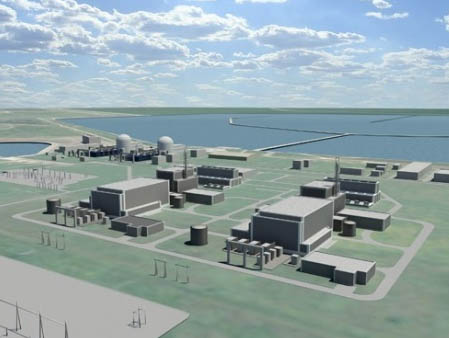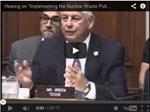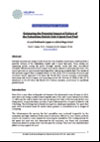Author Archive
State Of Washington Lambastes Trump Administration Plan To Reclassify Nuke Waste
January 09, 2019
The state has objected to a federal proposal to reclassify millions of gallons of radioactive waste as less dangerous.
This May 13, 2017 file photo shows the Hanford Nuclear Reservation near Richland, Wash. The state of Washington said Tuesday,
ASSOCIATED PRESS
This May 13, 2017 file photo shows the Hanford Nuclear Reservation near Richland, Wash. The state of Washington said Tuesday, Jan. 8, 2019 that it opposes a federal proposal to reclassify as less dangerous some radioactive waste stored in underground tanks at the site. State officials said Tuesday they fear the change will allow the federal government to walk away from its obligation to clean up millions of gallons of radioactive waste.
SPOKANE, Wash. (AP) — The state of Washington said Tuesday it opposes a federal proposal to reclassify as less dangerous some radioactive waste on a site in the state that contains the nation’s largest supply because it fears much of the waste will be left in the ground.
The state this week filed its objections to a Trump administration plan to reclassify millions of gallons of waste stored in underground tanks at Hanford Nuclear Reservation. The objections were accompanied by a letter from Gov. Jay Inslee and Attorney General Bob Ferguson.
The U.S. Department of Energy is seeking to reclassify a large percentage of the waste as lower-level waste. That would allow treatment and disposal options that would not guarantee long-term protections.
“This dangerous idea will only serve to silence the voices of tribal leaders, Hanford workers, public safety officials, and surrounding communities in these important conversations,” said Inslee, a Democrat who is considering running for president in 2020. “This is unacceptable, and we will not stand by while this administration plans to abandon its responsibility to clean up their mess.”
Hanford was established by the Manhattan Project in World War II to make plutonium, a key ingredient in the atomic bomb dropped on Nagasaki, Japan. The site, near Richland, Washington, went on to produce most of the plutonium for the nation’s nuclear arsenal.
As a result, the site also contains the nation’s largest collection of nuclear waste. The most dangerous is stored in 177 aging underground tanks, some of which have leaked.
Critics say that reclassifying some of the high-level radioactive waste to low-level could save the government billions of dollars and decades of work by essentially leaving the material in the ground.
Hanford tanks hold 60 percent of the nation’s most dangerous radioactive waste left over from nuclear weapons production.
Cleanup efforts at Hanford have been underway since the late 1980s and cost about $2 billion a year.
Currently, all of that waste is classified as high-level. Plans for its treatment and disposal have been developed to isolate it from the environment until it is no longer dangerous.
Current law defines high-level radioactive waste as resulting from processing irradiated nuclear fuel that is highly radioactive. The Energy Department wants to reclassify some of the waste if it meets highly technical conditions.
The agency says the change could save the federal government $40 billion in cleanup costs across the nation’s entire nuclear weapons complex, which includes the Savannah River Plant in South Carolina and Idaho National Laboratory.
The agency can make the change without the approval of Congress.
This document contains copyrighted material whose use has not been specifically authorized by the copyright owner. SEED Coalition is making this article available in our efforts to advance understanding of ecological sustainability, human rights, economic democracy and social justice issues. We believe that this constitutes a "fair use" of the copyrighted material as provided for in section 107 of the US Copyright Law. If you wish to use this copyrighted material for purposes of your own that go beyond "fair use", you must obtain permission from the copyright owner.
Here’s What Happened When The Government Lost Control Of The Biggest Nuclear Cleanup In The US
"This is 2018. We shouldn’t still be contaminating people with plutonium," said a worker at the Hanford site in eastern Washington.
July 19, 2018
Headshot of Zahra Hirji
Zahra Hirji, Reporter
BuzzFeed News

As November turned to December, rumors spread through the western corner of the former nuclear weapons plant in eastern Washington. Bo-J and his anxious coworkers at the old Hanford plant would talk on lunch breaks about radioactive particles showing up on gear, and newly roped-off areas of contamination.
"There was talk, not real clarification," Bo-J told BuzzFeed News. "Next thing you know — boom! — a stop-work."
On Dec. 13, 2017, after the gear on half a dozen employees had tested "hot," labor unions refused to keep working, and demolition ground to a halt. It was the beginning of one of the worst contamination events at Hanford, a sprawling site that once produced the plutonium for the bomb dropped on Nagasaki and whose cleanup will take most of this century.
The company running this project, a government contractor called CH2M Hill Plateau Remediation Company, quickly agreed to the union demands, and work resumed. But just one day later, hot particles were found outside of the fenced-off demolition site — an ominous sign that the radioactivity had not been contained.
Workers rushed to get tested. Bo-J filled a "shit kit" — white plastic tubs resembling Cool Whip containers — with his poop, had it sent to a lab across the country, and waited.
His job had always been dangerous, of course. To avoid exposure, he wore white fabric coveralls, boots and boot covers, layers of gloves, and a hooded face mask connected to an air filter. He knew that nuclear radiation can cause cancer and infertility, and he knew that, even under the best of circumstances, accidents happen.
Read full article on BuzzFeed News site….
This document contains copyrighted material whose use has not been specifically authorized by the copyright owner. SEED Coalition is making this article available in our efforts to advance understanding of ecological sustainability, human rights, economic democracy and social justice issues. We believe that this constitutes a "fair use" of the copyrighted material as provided for in section 107 of the US Copyright Law. If you wish to use this copyrighted material for purposes of your own that go beyond "fair use", you must obtain permission from the copyright owner.
Toshiba scraps project to build ABWRs in Texas
31 May 2018
World Nuclear News
Japan’s Toshiba Corporation is to withdraw from the project to construct two of its advanced boiling water reactors (ABWRs) as units 3 and 4 of the South Texas Project (STP) in the USA. The company said the project, which has failed to find investors, is no longer financially viable.

An impression of how the two ABWRs would have appeared at STP (Image: STPNOC)
Toshiba – through its US-based wholly-owned subsidiary Toshiba America Nuclear Energy Corporation (TANE) – and US utility NRG Energy founded Nuclear Innovation North America (NINA) in 2008 to promote the use of Toshiba’s ABWR in North America. A combined construction and operating licence (COL) application for two ABWRs at STP, where NRG Energy already operates two pressurised water reactors, had already been submitted to the Nuclear Regulatory Commission (NRC) in 2007. In February 2009, TANE signed an engineering, procurement and construction (EPC) contract with STP Nuclear Operating Company, acting as an agent for NINA, and thereby became the main contractor for STP units 3 and 4. However, in 2011 NRG Energy announced that it would be withdrawing from the project and writing down its USD331 million investment in NINA. Since then, Toshiba has bankrolled the licensing process.
The NRC notified NINA in late 2011 that the corporation did not meet the foreign ownership requirements and would therefore be ineligible to receive a licence; however NINA subsequently filed revisions to its COL application and a "negation action plan" to address the issue. The NRC told NINA that it will continue to review the remaining portions of the COL application while the company "considers its options", but will not issue a licence until the foreign ownership requirements are met. The NRC Atomic Safety Licensing Board has since ruled that Toshiba’s formal 10% ownership of NINA was acceptable and the COLs for STP 3 and 4 were eventually granted in February 2016.
Toshiba announced today that its board had decided TANE will withdraw from the project. "Toshiba will proceed with the necessary procedures for the withdrawal with all related parties, and target its early completion," the company said. It expects to complete its withdrawal by the end of this year.
"The economic circumstances supporting the project have declined as a result of significant decreases in electricity rates due to the shale gas revolution, and the trend to tighter regulation of nuclear power plants in the aftermath of the Great East Japan Earthquake," Toshiba said. "Under current and expected economic conditions, further development of STP units 3 and 4 has ceased to be financially viable. In addition, maintaining the project incurs continuous costs, and no investors have expressed an interest in participation." It continued, "In these circumstances, there is no clear pathway to securing profitability and Toshiba has decided to completely withdraw from the project. The company has resolved to cancel all contracts related to NINA, the EPC contract and deferred loans, and to forgive loans under loan contracts."
Toshiba said its decision to exit the STP units 3 and 4 project is in line with its basic policy "to eliminate risk from the overseas nuclear power business, particularly from construction-related cost overruns in nuclear power plant construction projects, by withdrawing from projects where Toshiba Group serves as prime contractor or has to bear risk from construction-related cost overruns".
The company said that, as of today, it has claims of USD641 million and an equity interest of USD147 million in the US ABWR project. However, it noted that it recorded allowances for most of all bad debt and impairment loss by FY2017, which ended 31 March 2018, and the impact on business results in FY2018 "will be minimal".
Researched and written
by World Nuclear News
This document contains copyrighted material whose use has not been specifically authorized by the copyright owner. SEED Coalition is making this article available in our efforts to advance understanding of ecological sustainability, human rights, economic democracy and social justice issues. We believe that this constitutes a "fair use" of the copyrighted material as provided for in section 107 of the US Copyright Law. If you wish to use this copyrighted material for purposes of your own that go beyond "fair use", you must obtain permission from the copyright owner.
A Letter from Tim Powell: Toshiba withdraws from STP Units 3 and 4
06/07/2018
Bay City Sentinel
Toshiba Corporation announced May 31 that Toshiba America Nuclear Energy Corporation is withdrawing from the effort to build South Texas Project Units 3 and 4.
This decision was based on their belief that under expected economic conditions, further development of STP Units 3 and 4 has ceased to be financially viable.
In the coming weeks, we expect a meeting of NINA’s Board of Directors to determine the future of STP Units 3 and 4.
At STP, we want to thank the Community for their support of the effort to bring Units 3 and 4 to fruition.
Countless hours of hard work have been dedicated toward the development of Units 3 and 4. While we are disappointed to find ourselves in the position we are in today, I am proud of the work we’ve done, working together, to reach this goal.
While the further development of Units 3 and 4 are in question, I want to assure you that the safe and reliable operation of Units 1 and 2 remains the commitment of each and every employee at STP.
These units continue to be vital to the resilience and reliability of the Texas grid and we are focused on maintaining the exemplary performance we have achieved and creating further value for the community we call home.
Again, I want to express the appreciation STP has for this community, its leaders, and all of the incredible people who have offered their ongoing support to our mission.
With our recently granted 20-year life extension for Units 1 and 2, that mission will continue today, tomorrow and for many years to come.
STP remains a proud partner of Matagorda County and the South Texas region for over 30 years and will remain so as we continue to move forward.
Tim Powell
President and Chief Executive Officer
STP Nuclear Operating Company
This document contains copyrighted material whose use has not been specifically authorized by the copyright owner. SEED Coalition is making this article available in our efforts to advance understanding of ecological sustainability, human rights, economic democracy and social justice issues. We believe that this constitutes a "fair use" of the copyrighted material as provided for in section 107 of the US Copyright Law. If you wish to use this copyrighted material for purposes of your own that go beyond "fair use", you must obtain permission from the copyright owner.
Orano, WCS Aim to Revive Spent Fuel Storage Project
MARCH 14, 2018
BY EXCHANGEMONITOR
Nearly a year after putting it on ice, Waste Control Specialists aims to revive its application for a U.S. Nuclear Regulatory Commission license to build and operate a facility for consolidated interim storage of used fuel from commercial nuclear power reactors. It is doing so in a joint venture planned with Orano USA.
Establishment of the joint venture and a formal request to restart the NRC review are expected in the second quarter of this year, said Jeffery Isakson, vice president of business operations at Orano subsidiary TN Americas, who is working on the spent fuel storage project.
The plan remains to build a facility on Waste Control Specialists’ property in Andrews County, Texas, to temporarily hold up to 40,000 metric tons of spent fuel until the Department of Energy finds a permanent home for the radioactive waste.
In a joint press release, the companies touted the experience they will bring to the project: Orano’s (formerly AREVA) capabilities in fuel packaging, storage, and transportation, and Waste Control Specialists’ operation of a disposal facility for low-level radioactive and other waste forms from the commercial and government sectors. Isakson said he could not yet discuss details of what each company will provide operationally to the joint venture.
“When the NRC receives the WCS request to resume, the staff will develop a new schedule for continuing the review, publish a new notice of hearing on this license application, and re-open the environmental scoping period for 60 days using our established procedures for these activities,” NRC spokesman David McIntyre said by email Tuesday.
Waste Control Specialists first submitted its application in April 2016, in partnership with NAC International and AREVA. The NRC completed its acceptance review of the application in January 2017, but the company in April of that year asked that the regulator halt the full technical review ahead of WCS’ then-pending merger with EnergySolutions. A federal judge blocked that deal on antitrust grounds, and Waste Control Specialists was acquired in January by private equity firm J.F. Lehman.
Orano USA was previously AREVA Nuclear Materials prior to its parent company’s renaming in January
This document contains copyrighted material whose use has not been specifically authorized by the copyright owner. SEED Coalition is making this article available in our efforts to advance understanding of ecological sustainability, human rights, economic democracy and social justice issues. We believe that this constitutes a "fair use" of the copyrighted material as provided for in section 107 of the US Copyright Law. If you wish to use this copyrighted material for purposes of your own that go beyond "fair use", you must obtain permission from the copyright owner.



